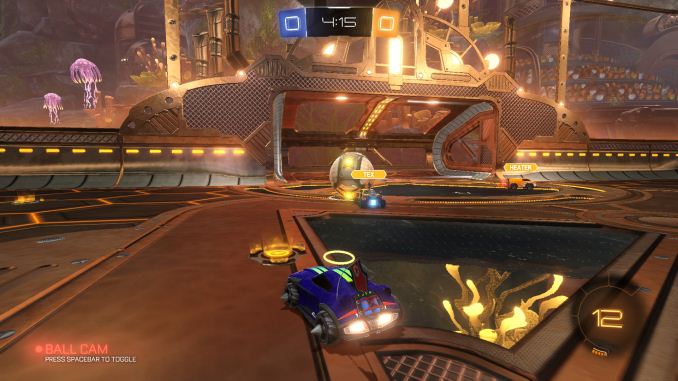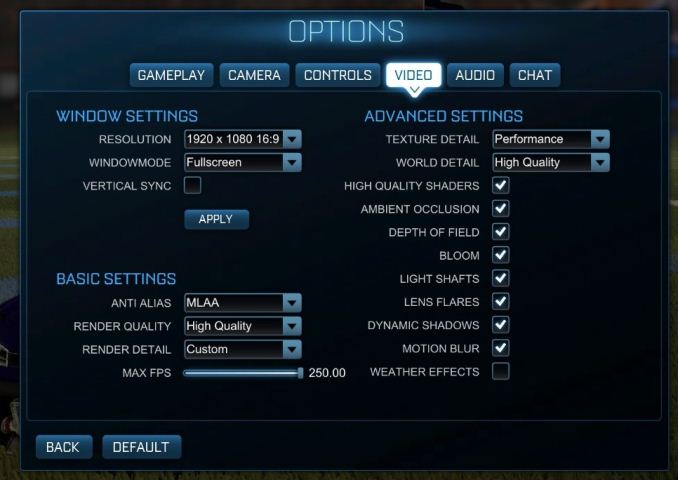Retesting AMD Ryzen Threadripper’s Game Mode: Halving Cores for More Performance
by Ian Cutress on August 17, 2017 12:01 PM ESTRocket League
Hilariously simple pick-up-and-play games are great fun. I'm a massive fan of the Katamari franchise for that reason — passing start on a controller and rolling around, picking up things to get bigger, is extremely simple. Until we get a PC version of Katamari that I can benchmark, we'll focus on Rocket League.
Rocket League combines the elements of pick-up-and-play, allowing users to jump into a game with other people (or bots) to play football with cars with zero rules. The title is built on Unreal Engine 3, which is somewhat old at this point, but it allows users to run the game on super-low-end systems while still taxing the big ones. Since the release in 2015, it has sold over 5 million copies and seems to be a fixture at LANs and game shows. Users who train get very serious, playing in teams and leagues with very few settings to configure, and everyone is on the same level. Rocket League is quickly becoming one of the favored titles for e-sports tournaments, especially when e-sports contests can be viewed directly from the game interface.
Based on these factors, plus the fact that it is an extremely fun title to load and play, we set out to find the best way to benchmark it. Unfortunately for the most part automatic benchmark modes for games are few and far between. Partly because of this, but also on the basis that it is built on the Unreal 3 engine, Rocket League does not have a benchmark mode. In this case, we have to develop a consistent run and record the frame rate.
Read our initial analysis on our Rocket League benchmark on low-end graphics here.
With Rocket League, there is no benchmark mode, so we have to perform a series of automated actions, similar to a racing game having a fixed number of laps. We take the following approach: Using Fraps to record the time taken to show each frame (and the overall frame rates), we use an automation tool to set up a consistent 4v4 bot match on easy, with the system applying a series of inputs throughout the run, such as switching camera angles and driving around.
It turns out that this method is nicely indicative of a real bot match, driving up walls, boosting and even putting in the odd assist, save and/or goal, as weird as that sounds for an automated set of commands. To maintain consistency, the commands we apply are not random but time-fixed, and we also keep the map the same (Aquadome, known to be a tough map for GPUs due to water/transparency) and the car customization constant. We start recording just after a match starts, and record for 4 minutes of game time (think 5 laps of a DIRT: Rally benchmark), with average frame rates, 99th percentile and frame times all provided.
The graphics settings for Rocket League come in four broad, generic settings: Low, Medium, High and High FXAA. There are advanced settings in place for shadows and details; however, for these tests, we keep to the generic settings. For both 1920x1080 and 4K resolutions, we test at the High preset with an unlimited frame cap.
All of our benchmark results can also be found in our benchmark engine, Bench.
MSI GTX 1080 Gaming 8G Performance

1080p



4K



Sapphire Nitro R9 Fury 4G Performance

1080p



4K



Sapphire Nitro RX 480 8G Performance

1080p



4K



With Ryzen, we encounted some odd performance issues when using NVIDIA-based video cards that caused those cards to significantly underperform. However equally strangely, the issues we have with Ryzen on Rocket League with NVIDIA GPUs seem to almost vanish when using Threadripper. Again, still no easy wins here as Intel seems to take Rocket League in its stride, but Game mode still helps the 1950X. The Time Under graphs give some cause for concern, with the 1950X consistently being at the bottom of that graph.












104 Comments
View All Comments
Lieutenant Tofu - Friday, August 18, 2017 - link
"... we get an interesting metric where the 1950X still comes out on top due to the core counts, but because the 1920X has fewer cores per CCX, it actually falls behind the 1950X in Game Mode and the 1800X despite having more cores. "Would you mind elaborating on this? How does the proportion of cores per CCX affect performance?
JasonMZW20 - Sunday, August 20, 2017 - link
The only thing I can think of is CCX cache locality. Given a choice, you want more cores per CCX to keep data on that CCX rather than using cross-communication between CCXes through L2/L3. Once you have to communicate with the other CCX, you automatically incur a higher average latency penalty, which in some cases, is also a performance penalty (esp. if data keeps moving between the two CCXes).Lieutenant Tofu - Friday, August 18, 2017 - link
On the compile test (prev page):"... we get an interesting metric where the 1950X still comes out on top due to the core counts, but because the 1920X has fewer cores per CCX, it actually falls behind the 1950X in Game Mode and the 1800X despite having more cores. "
Would you mind elaborating on this? How does the proportion of cores per CCX affect performance?
rhoades-brown - Friday, August 18, 2017 - link
This gaming mode intrigues me greatly- the article states that the PCIe lanes and memory controller is still enabled, but the cores are turned off as shown in this diagram:http://images.anandtech.com/doci/11697/kevin_lensi...
If these are two complete processors on one package (as the diagrams and photos show), what impact does having gaming mode enabled and a PCIe device connected to the PCIe controller on the 'inactive' side? The NUMA memory latency seems to be about 1.35 surely this must affect the PCIe devices too- further how much bandwidth is there between the two processors? Opteron processors use HyperTransport for communication, do these do the same?
I work in the server world and am used to NUMA systems- for two separate processor packages in a 2 socket system, cross-node memory access times is normally 1.6x that of local memory access. For ESXi hosts, we also have particular PCIe slots that we place hardware in, to ensure that the different controllers are spread between PCIe controllers ensuring the highest level of availability due to hardware issue and peek performance (we are talking HBAs, Ethernet adapters, CNAs here). Although, hardware reliability is not a problem in the same way in a Threadripper environment, performance could well be.
I am intrigued to understand how this works in practice. I am considering building one of these systems out for my own home server environment- I yet to see any virtualisation benchmarks.
versesuvius - Friday, August 18, 2017 - link
So, what is a "Game"? Uses DirectX? Makes people act stupidly? Is not capable of using what there is? Makes available hardware a hindrance to smooth computing? Looks like a lot of other apps (that are not "Game") can benefit from this "Gaming Mode".msroadkill612 - Friday, August 18, 2017 - link
A shame no Vega GPU in the mix :(It may have revealed interesting synergies between sibling ryzen & vega processors as a bonus.
BrokenCrayons - Friday, August 18, 2017 - link
The only interesting synergy you'd get from a Threadripper + Vega setup is an absurdly high electrical demand and an angry power supply. Nothing makes less sense than throwing a 180W CPU plus a 295W GPU at a job that can be done with a 95W CPU and a 180W GPU just as well in all but a few many-threaded workloads (nevermind the cost savings on the CPU for buying Ryzen 7 or a Core i7).versesuvius - Friday, August 18, 2017 - link
I am not sure if I am getting it right, but apparently if the L3 cache on the first Zen core is full and the core has to go to the second core's L3 cache there is an increase in latency. But if the second core is power gated and does not take any calls, then the increase in latency is reduced. Is it logical to say that the first core has to clear it with the second core before it accesses the second core's cache and if the second core is out it does not have to and that checking with the second core does not take place and so latency is reduced? Moving on if the data is not in the second core's cache then the first core has to go to DRAM accessing which supposedly does not need clearance from the second core. Or does it always need to check first with the second core and then access even the DRAM?BlackenedPies - Friday, August 18, 2017 - link
Would Threadripper be bottlenecked by dual channel RAM due to uneven memory access between dies? Is the optimal 2 DIMM setup one per die channel or two on one die?Fisko - Saturday, August 19, 2017 - link
Anyone working on daily basis just to view and comment pdf won't use acrobat DC. Exception can be using OCR for pdf. Pdfxchange viewer uses more threads and opens pdf files much faster than Adobe DC. I regularly open files from 25 to 80 mb of CAD pdf files and difference is enormous.